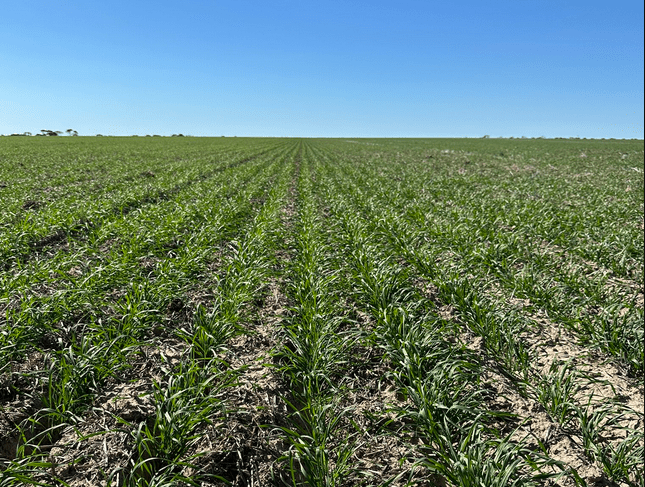
One of Australia’s more advanced wheat crops, this paddock of Denison was sown April 9 and photographed May 10 in the north of Western Australia’s Esperance Zone. In contrast, much of South Australia, western Victoria, and southern New South Wales are yet to get the rain needed to germinate dry-sown crops. Photo: Tim Starcevich
PLANTING of Australia’s 2025-26 wheat crop is in full swing, and the USDA overnight released its initial estimate for production at 31 million tonnes (Mt).
The figure was released in the May World Agricultural Supply and Demand Estimates, and in the accompanying Grain: World Markets and Trade report, USDA has forecast record global wheat production in 2025-26 of 808.5Mt, up 8.8Mt from the previous year.
| 2024-25 prodn | 2024-25 exports | 2025-26 prodn | 2025-26 exports | |
| Argentina | 18.5 | 11 | 20 | 13 |
| Australia | 34.1 | 25 | 31 | 23 |
| Canada | 35 | 27 | 36 | 27 |
| EU | 122.1 | 26.5 | 136 | 34 |
| Russia | 81.6 | 43.5 | 83 | 45 |
| Ukraine | 23.4 | 16 | 23 | 16.5 |
| US | 53.7 | 22.3 | 52.3 | 21.8 |
Table 1: Estimates in million tonnes for 2024-25 wheat production and exports and initial forecasts for 2025-26 for world’s seven major exporters. Source: USDA
“The European Union is up 13.9 million tons, recovering from the prior year’s weather difficulties that lowered yields and quality,” the report said, adding that yields in Russia were expected to improve, resulting in a 2-percent increase in its crop.
“For Ukraine, unfavourable weather conditions during planting and the ongoing war are key factors in a 2pc reduction in production. “
Production in Canada at 36Mt is forecast to be the second-largest ever, while the US crop is forecast lower to reflect declining area.
“On the assumption of normal weather, Argentina is expected to have more favourable harvests.
“However, Australia is forecast to decline on lower harvested area and lower yields.
Egypt, Indonesia hold top import spots
In the year to June 2026, Egypt is seen as holding its place as the top global importer on 13Mt, up 500,000t on 2024-25.
“Egypt continues to implement its long-standing bread subsidy program, while the private sector also accounts for a significant portion of imports,” the FAS report said.
“In addition to wheat milled for domestic use, Egypt is also expected to continue exporting some wheat flour to nearby countries such as Sudan.
In Asia, imports are forecast to rebound, led by China, which is expected to ship in 6Mt in 2025-26, up from 3.3Mt in 2024-25.
“South-east Asia wheat imports are set to increase, especially with higher demand in Indonesia, the largest importer in the region where milling wheat demand is growing.”
Increased consumption with strong growth for instant noodle and other wheat products are seen as driving the lift in Indonesia’s demand.
“Imports are also up for The Philippines, with higher food and feed use.”
USDA forecasts Indonesia’s imports for 2025-26 at 12Mt, up 500,000t on the previous year, and 100,000t increases for both South Korea and Vietnam to 4.5Mt and 5.4Mt respectively.
Japan’s wheat imports are seen as steady at 5.45Mt, while imports for The Philippines are forecast to rise 200,000t to 7.4Mt, and Thailand’s imports are seen as dropping 100,000t to 4Mt.
Varied in South Asia
India is expected to produce its biggest crop of recent years at 117Mt, and stocks are anticipated to continue rebounding with the improved harvest and the Indian Government’s prolonged export ban.
USDA expects Bangladeshi imports to climb 500,000t over the year to 7Mt to reflect population and per-capita consumption growth, and the wheat price being relatively low compared with rice.
“Pakistan is expected to significantly increase imports with its sharply lower production as the government has eliminated its procurement program with guaranteed minimum support prices, leading to lower planted area.”
The EU’s production recovery is tipped to lower import demand, with higher consumption for both food and feed expected to be met largely through domestic supplies.
Turkey’s 2025-26 imports are seen at 7.5Mt, up from 3.5Mt in 2024-25, with government policy allowing wheat imports by millers to be re-exported as wheat flour and pasta products.
Brazil is forecast to import 6.7Mt in 2025-26 as the largest importer of wheat in the Western Hemisphere, down from 7Mt in 2024-25 due to larger domestic production.
“In contrast, Mexico will import record volumes of wheat, with the lowest expected production in over 50 years.”
Source: USDA

HAVE YOUR SAY